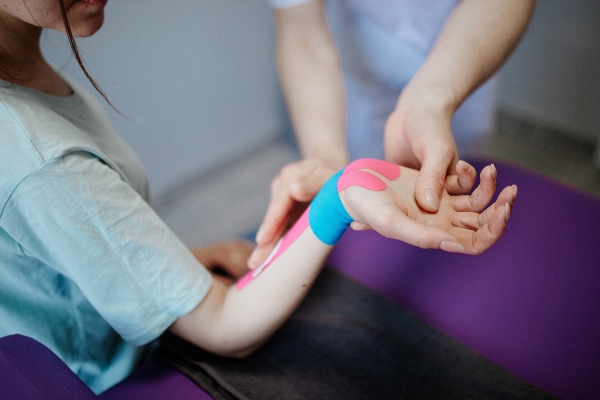By Annette. M. Zaharoff, M.D.
There are many types of treatments used in sports medicine to help injuries heal. Taping is one such treatment that has been used by athletes for many years. Recently, advances in taping techniques and materials have allowed even more effective treatment options to become available. Kinesio taping is one such method. Kinesio tape is used to facilitate healing and support areas that have been injured to allow athletes as well as weekend warriors to return to activity as soon as possible.
If you watched any of the 2009 Olympics, you may have noticed athletes from around the world sporting multi-colored tape like a badge of courage or a newly born tattoo. The tape which is intertwined around joints and ligaments as if to keep them from falling apart actually has a specific purpose and technique.
Kinesio tape is an elastic tape placed on the body to relieve tension support muscles and joints to allow them to heal. The Kinesio® Taping Method is applied over muscles to reduce pain and inflammation, relax overused or tired muscles and support muscles in movement on a 24-hour-a-day basis. It is not a restrictive type of taping and allows for full range of motion. In contrast, traditional sports taping is wrapped around a joint strictly for stabilization and support during an athletic event. Kinesio® Tex tape is used to treat anything from headaches to foot problems and everything in-between. Examples include rehabilitation from sports injuries, carpal tunnel syndrome, lower back strain/pain (subluxation, herniated disc), knee and shoulder conditions and more.
This taping method requires a tape that is patient and skin-friendly, possesses optimum elastic qualities, is the same thickness and elasticity as the skin and that is durable enough to stay on for multiple days, even through sweating and showers.
Tape application
Without getting too technical, the tape is applied over the affected area with the muscles in a stretched position. Then the tape is applied from one end of the muscle to the other with very little to no stretch on the tape. The tape is applied from the origin to insertion of the muscle for support and from insertion to origin to reduce tension. There are also multiple applications to support joint motion as well.
There are many different colors available for Kinesio tape but there is no physical difference between the colors. Color choice is a matter of individual preference. Kinesio tape will not affect bio-mechanics of the patient. Latex-free, Kinesio® Tex Tape is safe for sensitive skin and for populations ranging from pediatric to geriatric.
If you are injured, talk to your sports medicine physician and find out if Kinesio tape may be helpful in your rehabilitation program. You can also visit my Web site, www.drZmd.com, for more information.
Dr. Annette Zaharoff is a sports medicine physician specializing in the non-surgical evaluation and treatment of injuries. She maintains a private practice in San Antonio and may be reached by calling her office at (210) 616-0646 or visiting her Web site www.drZmd.com






